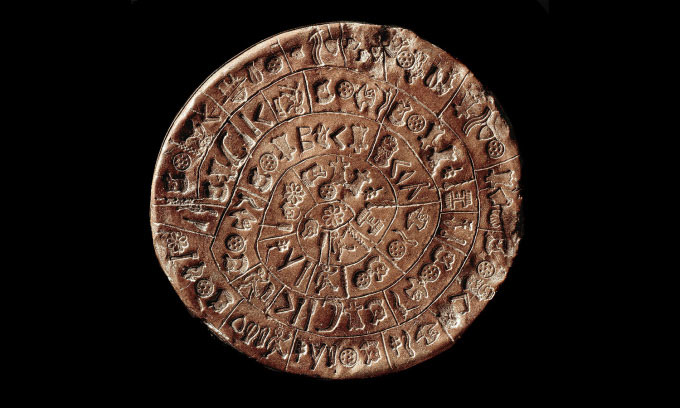3,000-year-old engraved plate cannot be deciphered
Unearthed more than 100 years ago, the Phaistos Disc is engraved with mysterious symbols in a spiral shape that still baffles experts today.
The Phaistos Disc was discovered in 1908 by Italian archaeologist Luigi Pernier in the ruins of a palace at Phaistos, an archaeological site on the southern coast of Crete, Greece. The disc is made of baked clay and is engraved with mysterious symbols that have never been deciphered. Initially, some scholars believed the Phaistos Disc was a fake, but today most accept it as authentic. They believe the artifact originated from the Minoan civilization and was made more than 3,000 years ago.

More than 100 years after the discovery of the Phaistos Disc, scientists have yet to decipher this ancient artifact. (Photo: Leemage).
The Minoans were a Bronze Age people who lived on the island of Crete and nearby islands in the eastern Mediterranean. Their civilization was famous for its art and architecture, and is believed to have inspired the Mycenaean civilization in Greece.
In the 19th century, when their incredible remains were unearthed, experts named this civilization Minoan after King Minos of Greek mythology, who imprisoned the Minotaur in a labyrinth under his castle at Knossos, Crete, until the monster was killed by the hero Theseus. However, experts believe that the Minoans lived on Crete around 3100 - 1150 BC, many centuries before Minos and Theseus appeared.
The Phaistos Disc is about 15 centimeters in diameter , and is engraved with symbols in two spirals on both sides. Most experts believe that these symbols are a type of writing. But despite many efforts over the past century, they have not been able to figure out their meaning.
In total, the disk contains 45 symbols that appear 241 times. Some of the symbols clearly depict people, while others depict animals, plants, weapons, tools, and various other objects. They are grouped into 'words' with vertical strokes, but there is no information about their pronunciation or function.
Initial interpretations suggested that the symbols on the Phaistos Disc were a form of ancient Greek writing, depicting an animal sacrifice taking place in a temple. However, a 2004 interpretation suggested that the symbols formed a letter about a land dispute written in the Luwian language of ancient Anatolia (modern-day Turkey). Other experts have suggested that the disc is written in Hittite, Egyptian, or a prayer to a goddess, or a funeral song written in an unknown language.
- The mystery of the stone engraved with a 1,600-year-old message
- Discovered a 2,000-year-old iron pen engraved in English
- 2,500-year-old curse card in ancient well
- Prayer for mother on a 4,000 year disc
- 'Diet Plate': Eating plate to prevent obesity
- Mysterious beautiful face engraved on a 2,000-year-old sapphire ring of the Roman emperor
- Tips for making door lock easily from ... plate
- The bottom of North America plate tectonics is
- Discovered many ancient thousand-year bricks in Ho's Citadel
- Eating plates help cut calories
- Mexico earthquake 'torn' a tectonic plate
- The person who is engraved with the
 The truth about the mysterious red-haired giant at Lovelock Cave
The truth about the mysterious red-haired giant at Lovelock Cave Inunaki Tunnel: The haunted road leading into Japan's 'village of death'
Inunaki Tunnel: The haunted road leading into Japan's 'village of death' The mystery of the phenomenon of human reflection before dying
The mystery of the phenomenon of human reflection before dying 6 mysterious phenomena, although science has been developed for a long time, still cannot be answered
6 mysterious phenomena, although science has been developed for a long time, still cannot be answered